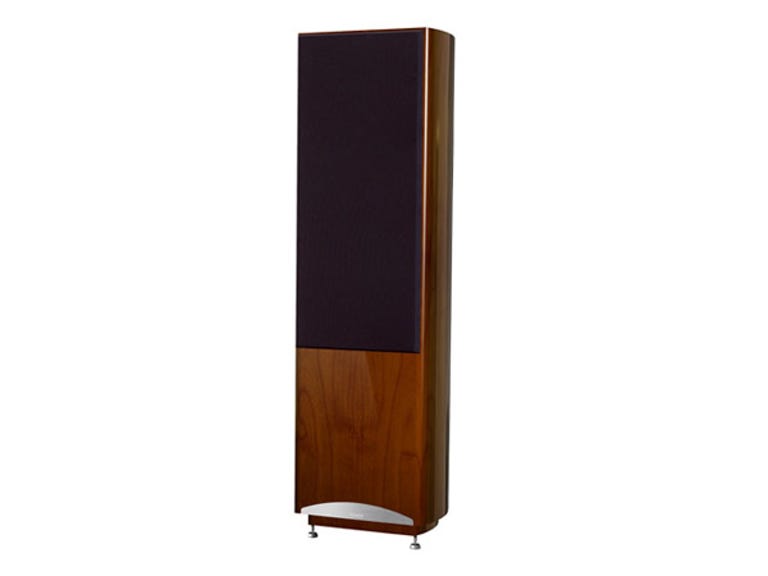 Why You Can Trust CNET
Why You Can Trust CNET Tannoy Definition DC10T stereo loudspeakers review: Tannoy Definition DC10T stereo loudspeakers
Offering exceptional power and an immaculate finish, the Tannoy Definition DC10T speakers have very few limitations.
Tannoy has been around for a very long time. Indeed, in the UK, a public address loudspeaker is often called a "Tannoy".
The Good
The Bad
The Bottom Line
But this brand is not just venerable; the Tannoy Definition DC10T loudspeakers are exceptionally elegant.
System
Imagine the most beautifully finished, high-gloss, wood-grain piano that you've ever seen, and that's what you can expect to see when you open the carton containing a Tannoy Definition DC10T loudspeaker. Absolutely gorgeous in finish, they also are extremely solid in construction. Each weighs nearly 35 kilograms.
Most speakers these days present a fairly narrow face to the room. These don't. In order to accommodate their two 250mm drivers in each enclosure, they are actually about 340mm wide. The sides of the enclosures curve to a narrower rear. On the supplied spikes, each stands at about 1125mm tall.
At the bottom of the two large drivers in each enclosure is a bass driver. Really, that's all it does; it is responsible for the frequencies from the loudspeaker's bottom end of 30 hertz up to 200 hertz, where it hands over to the top, 250mm unit.
That top one looks obviously different, because it has at its centre a hole in which resides a 25mm titanium dome tweeter. Yes, another concentric driver. Tannoy has been doing this for a very long time, though. An advantage of this is that at the crossover point (1400 hertz), there is very little opportunity for destructive interference between the drivers, due to different path lengths to the ears. The tweeter is pushed back quite a way into the centre of the larger driver, primarily in order to "time align" the drivers. Tweeters tend to be more responsive to the signal than the larger drivers, so, by making this adjustment, the wave front of the lower and upper frequencies from the same instrument can be aligned with each other.
Tannoy talks about some strange stuff, such as freezing the crossover network to -190 degrees Celsius in order to "reduce the internal stresses in the microstructure" of it. Sounds a bit like one of those mystical practices that some hi-fi people get up to. Still, we don't suppose that it does any harm.
What was interesting was the provision of five binding posts on each speaker. Four were for the usual bi-wiring (if you want to waste a bit of money on extra wire) of the drivers, while the fifth is something that we've never seen before: an earthing point. Apparently, this allows the chassis of both drivers to be grounded. We didn't try this out, because we didn't have a grounding point handy (apart from the ones in power points, which we'd be very reluctant to use).
Sound
These speakers accept quite high levels of power, and translate it from electrical into acoustical form with higher-than-normal efficiency, yielding a sensitivity of 92dB (each 3dB increase is equivalent to doubling the amount of power).
Consequently, these speakers were very happy to go extremely loud when we opened up the throttle on the 200-watt mono-block amplifiers. They went loud, but preserved the coherence of the sound as they did so, even at volume levels averaging over 100dB SPL. Want rock played loud? These speakers will do it.
The character of the sound was one of full, rich bass, and excellent detail throughout the tonal range. In my room, the mid-bass was a touch more forward than the norm. Tannoy provides "bungs" — foam rubber cylinders — that can be placed in the bass reflex ports to tame the bass, should circumstances require the speakers to be placed close to a wall. In our room, the position complied with Tannoy's suggestions of a good metre of separation from a wall, but even here, we think the bass may have been just a touch fuller than we're used to.
We switched to an orchestral piece, and again there was that mid-bass richness, but a real feeling of presence in the instruments. And a very tangible sense of stereo imaging, in which just about each individual instrument could be picked out in space from the others. The slide of the bow across the strings of the violin was delivered with a texture that spoke of realism.
Overall
So loud and brash, smooth and sophisticated, the Tannoy Definition DC10T loudspeakers will deliver pretty much what you want. Just make sure that your room has space for them, including that necessary distance from the surrounding walls.


